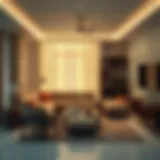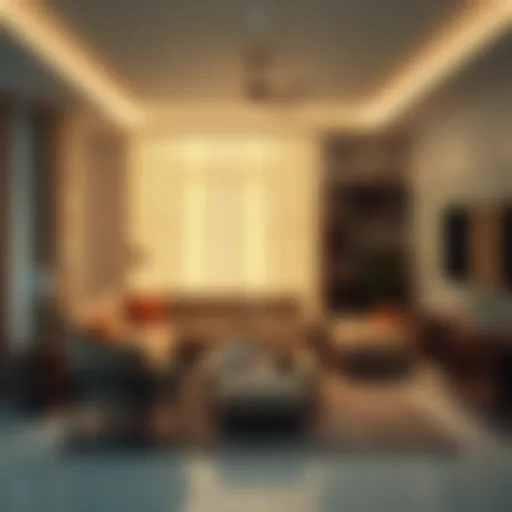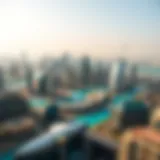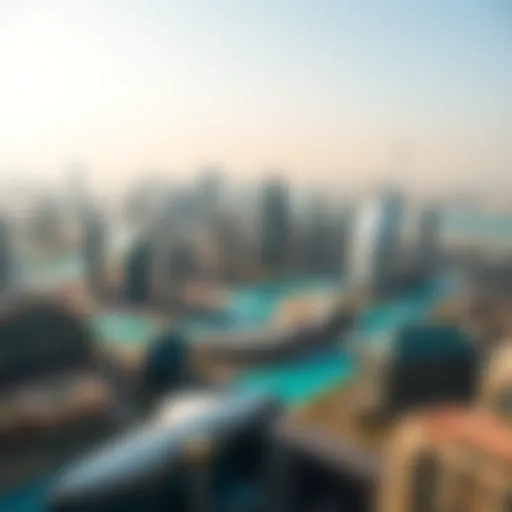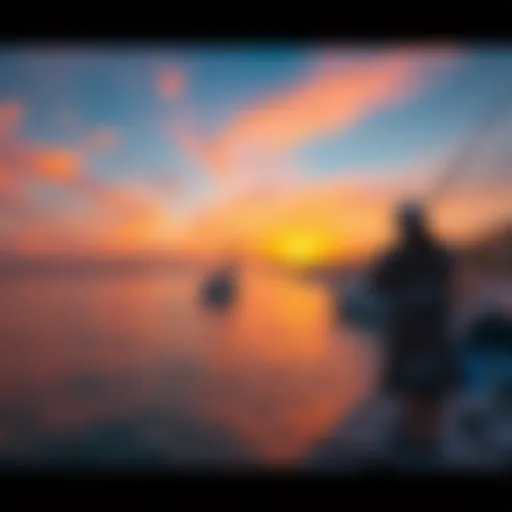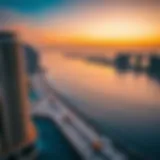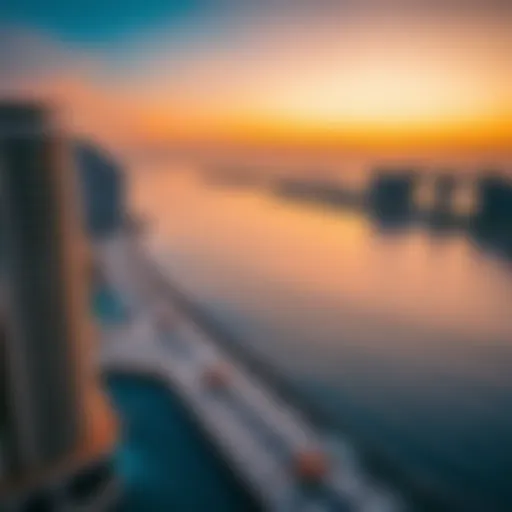Discovering Ras Al Khor Sanctuary: Dubai's Ecological Treasure
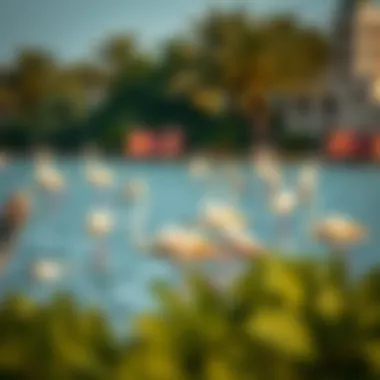

Intro
Ras Al Khor Sanctuary, situated in the heart of Dubai, is often overshadowed by the glitz and glamor that characterizes the city. However, this remarkable natural site serves as a vital ecological haven, offering a glimpse into the rich biodiversity that thrives, even amidst one of the most rapidly developing urban centers in the world. Its significance extends beyond just lush landscapes; the sanctuary stands as a testament to Dubai's ongoing commitment to wildlife conservation.
As urbanization continues its relentless march forward, Ras Al Khor becomes a beacon of hope for environmentalists and nature lovers alike. It is not merely a refuge for migratory birds, but a crucial component of the ecological equilibrium that keeps the city's natural heritage alive. \nThis article aims to navigate through the sanctuary’s diverse habitats, present the incredible variety of species that find solace there, and underscore the collaborative efforts between the government and local communities aimed at preserving this invaluable resource.
Whether you are an avid birdwatcher, a casual nature enthusiast, or someone interested in sustainable tourism, Ras Al Khor Sanctuary offers a unique perspective on the natural world that coexists with Dubai's urban landscape.
Preamble to Ras Al Khor Sanctuary
Ras Al Khor Sanctuary embodies a rich tapestry of life and nature, offering a refreshing contrast to the bustling urban environment surrounding it. This unique haven serves not just as a refuge for an impressive variety of wildlife, but also as a critical component of Dubai's ecological fabric. Understanding the sanctuary's significance can deepen our appreciation for biodiversity, particularly in metropolitan areas where natural habitats often face considerable threats.
Location and Overview
Nestled in the heart of Dubai, Ras Al Khor Sanctuary stretches over an area of approximately 6.2 square kilometers. Its proximity to the city’s high-rises and rapid development makes it an extraordinary example of how nature can coexist with urban expansion. The sanctuary is strategically located at the junction of Dubai Creek and the Arabian Gulf, which provides a diverse array of ecosystems, including mudflats, mangroves, and lagoons.
This oasis not only showcases the beauty of these habitats but also invites thousands of migratory birds each year, turning it into a focal point for bird watchers and nature enthusiasts alike. The sanctuary is well-connected, easily accessible from major roadways, making it a convenient spot for locals and visitors looking to immerse themselves in nature amidst the fast-paced urban life of Dubai.
Significance in Dubai’s Urban Landscape
In today’s fast-developing cityscape of Dubai, Ras Al Khor Sanctuary stands as a testament to the importance of preserving natural environments. With towering skyscrapers dominating the skyline, the sanctuary provides a necessary ecological balance, acting as a carbon sink that contributes to the overall environmental health of the area. It is a vital area for local wildlife, supporting various species that face habitat loss elsewhere due to urban sprawl.
Moreover, it serves as a critical educational resource. The sanctuary is home to several interpretive centers that facilitate learning about the region’s flora and fauna, opening a dialogue about sustainability among residents and visitors. The preservation of this sanctuary not only enhances biodiversity but also sparks interest in environmental conservation in a city primarily known for its luxury and innovation.
"Ras Al Khor Sanctuary is more than a natural oasis; it is an essential part of Dubai’s commitment to balancing urban progress with ecological responsibility."
In summary, Ras Al Khor Sanctuary plays a pivotal role in illustrating how nature can flourish amidst urban encroachment. By preserving this natural gem, Dubai supports not only its ecological integrity but also enhances the quality of life for its inhabitants through leisure and education.
Biodiversity of Ras Al Khor
The biodiversity of Ras Al Khor is not just a mere collection of plants and animals; it's a living mosaic that plays a crucial role in maintaining the ecological balance of the region. This sanctuary serves as a quintessential example of how urban areas can coexist with natural habitats. Rich in both flora and fauna, it offers critical benefits like supporting wildlife, providing essential ecosystem services, and enhancing the quality of life for nearby residents.
Ras Al Khor acts as a natural barrier against pollution and climate change impacts in the urban settings of Dubai. The variety of species found in the sanctuary contributes to resilience against environmental changes, further emphasizing the importance of its preservation.
Flora Found in the Sanctuary
The flora of Ras Al Khor is distinctive due to its unique mix of salt-tolerant plants known as halophytes, along with several other plant species that thrive in coastal ecosystems. Common varieties include mangroves, which are renowned for their ability to filter pollutants and protect shorelines from erosion. Other noticeable plants are the Avicennia marina and Rhizophora mucronata, both of which contribute a significant biomass to the environment.
Moreover, the sanctuary features rich intertidal zones with seagrasses like Halodule uninervis, providing not just a habitat for various marine creatures but also enhancing water quality by trapping sediments. Observing the plant life here can be surprisingly enchanting as they tell the story of adaptation and survival in harsh conditions.
Fauna of Ras Al Khor
Diving into the fauna, Ras Al Khor Sanctuary is home to an array of terrestrial and aquatic animals. The ecosystem here is quite diverse, boasting mammals, reptiles, and of course, a plethora of aquatic life. The sanctuary serves as a critical habitat for various species, including the Arabian Oryx and other mammals which prefer the salt flats and mudflats found throughout the area.
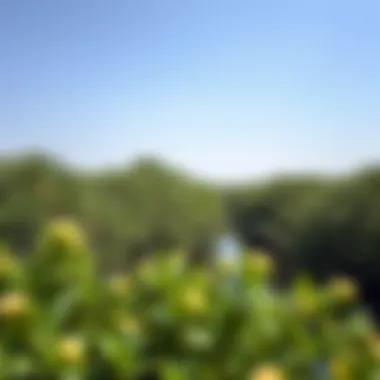

The waters are equally inviting for gilled residents. You can find fish species like mullet and grey mullet swimming around, while the lovingly nurtured mangroves offer shelter to crustaceans and other small marine species. This blend of species underpins a fragile balance that is vital for the entire ecosystem.
Migratory Bird Species
One of the most captivating aspects of Ras Al Khor is its role as a critical migratory stopover for birds. During migration seasons, bird watchers can spot a host of species, including the iconic flamingos, which have become synonymous with this sanctuary. More than 450 species of birds have been recorded, making this place a haven for ornithologists and enthusiasts alike.
The sanctuary supports both migratory and resident birds, encompassing species such as the Sandwich Tern and Black-winged Stilt. The area's unique landscape provides vital feeding, resting, and breeding grounds, making it a significant part of the migration route in the region.
Ecological Importance
In the heart of Dubai, Ras Al Khor Sanctuary is not just another green space; it is a vital ecological hub that plays significant roles within the city's environmental framework. Emphasizing the ecological importance of this sanctuary invites a closer examination of how it contributes to the local ecosystem and how it mitigates climate impacts. Understanding its ecological dynamics enhances our awareness of the delicate balance that holds together urban and natural environments.
Role in Local Ecosystem
Ras Al Khor serves as a critical habitat for numerous species. The sanctuary comprises various ecosystems, including mangroves, mudflats, and lagoons. These elements together offer a welcoming environment for wildlife, thereby promoting biodiversity. The mangrove trees, standing tall, act as natural barriers against coastal erosion and provide shelter for many aquatic species and migratory birds. Mangroves draw in nutrients from the water, playing a role similar to a sponge in maintaining the area’s water quality.
This sanctuary is more than a refuge for wildlife; it contributes to the overall well-being of Dubai's ecosystem. By fostering habitats, Ras Al Khor supports a range of species, from nimble small fish to grand flamingos. Maintaining these ecosystems ensures that species which may be sensitive to urban development have a foothold within the relentless expanse of concrete. Birds migrating from as far as Siberia find a temporary home here, relying on the sanctuary to rest and feed before continuing on their journeys.
Through this vibrant web of life, the sanctuary assists in sustaining the ecological balance that supports both wildlife and the human community surrounding it. So, what does this mean for residents and wildlife enthusiasts? It means witnessing a lively exchange of life forms and the assurance that urban development does not entirely overrun nature.
Impact on Climate Regulation
The role Ras Al Khor plays in climate regulation should not be underestimated. This sanctuary functions as a “green lung†of Dubai, absorbing carbon dioxide and releasing oxygen, thus contributing to cleaner air. Its diverse plant life reduces urban heat and also helps moderate local temperatures. The mangroves are particularly effective, as they store carbon in their biomass and in the sediment below.
Furthermore, these wetlands act as natural filters, ensuring that water entering the neighboring Arabian Gulf is cleaner than it would be without the sanctuary's presence. In mitigating the impacts of heavy rains or flooding, the sanctuary's habitats can absorb excess water, reducing runoff and minimizing flood risks to urban areas that might otherwise struggle under significant precipitation.
In brief, Ras Al Khor Sanctuary is not just a haven for biodiversity; it has tangible effects on climate stability. The combined impact of its ecosystems makes surrounding areas less vulnerable to extreme weather and climate-related challenges. As smart urban planning increasingly seeks to incorporate natural solutions, Ras Al Khor stands as a model worth emulating.
"Ras Al Khor Sanctuary exemplifies the delicate dance between urban life and nature, offering insights into how sustainable practices can harmonize coexistence."
In sum, the ecological importance of Ras Al Khor Sanctuary is multi-dimensional and reinforces the values of conservation amidst rapid urbanization. It represents not merely a refuge, but a crucial component of Dubai's environmental landscape, balancing the needs of wildlife, climate regulation, and urban life.
Conservation Efforts
The preservation of Ras Al Khor Sanctuary is of utmost importance not only to the wildlife that thrives within its bounds but also to the broader ecological health of Dubai. This urban oasis acts as a crucial buffer against the pervasive pressures of urbanization, making conservation efforts in this area vital. As the world continues to grapple with environmental issues like habitat loss and climate change, Ras Al Khor serves as a shining example of how society can come together to protect natural resources.
Government Initiatives
In Dubai, governing bodies have rolled up their sleeves to spearhead various initiatives aimed at safeguarding the sanctuary.
- Environmental Protection Policies: The Dubai Municipality has put forward comprehensive policies focusing on sustainable development. These policies not only safeguard the habitats within the sanctuary but also promote responsible tourism practices.
- Monitoring and Research: Regular assessments and studies are conducted to monitor the ecological integrity of the sanctuary. Institutions like the Dubai Wildlife Protection Office actively engage in research that informs the conservation strategies undertaken.
- Habitat Restoration Projects: Significant investment has gone into restoring degraded areas within the sanctuary. These projects not only enhance the living conditions for wildlife but also help restore native flora, which is essential for maintaining biodiversity.
“An ounce of prevention is worth a pound of cure,” echoes true here, as proactive measures help ensure that the sanctuary remains a vibrant ecosystem for generations to come.
Through these governmental initiatives, Ras Al Khor is positioned to weather the storm of urban pressures while maintaining its key role in local ecology.
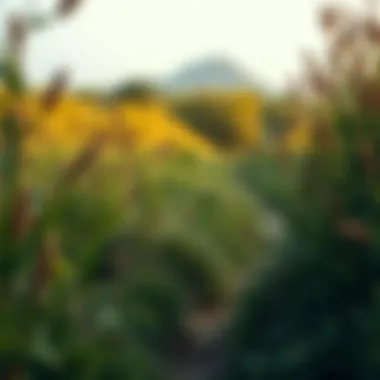

Community Involvement
The role of the local community cannot be overstated in the conservation of Ras Al Khor Sanctuary. When residents take pride and ownership of their natural surroundings, the positive impact is tangible.
- Voluntary Cleanup Drives: Many community groups organize events to clean up the sanctuary, which not only serves to beautify the area but also educates participants on the importance of protecting this vulnerable habitat.
- Awareness Campaigns: Local NGOs have been instrumental in raising awareness about the sanctuary’s significance, engaging schools, businesses, and local residents to participate in environmental stewardship.
- Citizen Science Programs: The involvement of the community goes a step further with initiatives that encourage citizens to contribute to wildlife monitoring efforts. Volunteers often assist in collecting data, which helps researchers gain insights into the sanctuary’s biodiversity.
In essence, the sum of both government initiatives and community involvement creates a formidable force for conservation. Together, they foster a culture of respect for nature, ensuring the long-term sustainability of Ras Al Khor Sanctuary, which continues to thrive amidst the urban sprawl of Dubai.
Challenges Facing the Sanctuary
Ras Al Khor Sanctuary, while a treasure trove of ecological diversity and beauty, grapples with significant challenges that threaten its stability and future. Understanding these obstacles is crucial as it not only highlights the vulnerabilities of this natural gem but also underscores the importance of collective efforts to preserve it. By delving into the issues of urban development pressure and climate change, we can better understand the sanctuary's precarious position and the urgent need for proactive measures.
Urban Development Pressures
The landscape around Ras Al Khor is continually evolving, with towering skyscrapers and sprawling residential areas encroaching upon its borders. This rapid urban expansion poses an existential threat to the sanctuary, impacting its delicate ecosystems. With more homes and businesses sprouting up, the sanctuary faces habitat loss, which can disrupt the balance of flora and fauna that thrive in this area.
Increased noise pollution, human activity, and the introduction of pollutants can disturb the migratory patterns of birds and other wildlife. Furthermore, the influx of people seeking recreational activities, such as jogging or birdwatching, although valuable in raising awareness, can inadvertently lead to habitat degradation. The sanctuary must find a way to accommodate the interests of city's inhabitants while retaining its core ecological integrity.
Moreover, as construction projects continue to materialize, water management becomes a significant concern. Changes in the hydrology of surrounding areas can lead to water quality issues, affecting the brackish lagoons crucial for numerous species. Effective planning is necessary to mitigate these threats and ensure that the urban sprawl does not overshadow the sanctuary's ecological importance.
Climate Change Impacts
Climate change isn't just a distant worry; it's knocking at the door of Ras Al Khor right now. Rising temperatures and shifting weather patterns bring a host of challenges that the sanctuary must confront. One major concern is the alteration of salinity levels in the wetlands, which can adversely affect the habitats that various species depend on. Many plant species and marine organisms are finicky about their environments; even slight changes can hinder their survival.
Additionally, the increasing frequency of extreme weather events—be it heavy rainfall or prolonged dry spells—can wreak havoc on the delicate ecosystems within the sanctuary. Flooding can lead to excess runoff filled with contaminants, while drought can stress water resources and reduce available habitats.
The broader implications of climate change may also hinder Ras Al Khor's potential as an eco-tourism destination, as shifting biodiversity might leave prospective visitors wondering where the famous flamingos have gone. If proactive steps are not taken by the authorities, many of the sanctuary's ecological treasures could become mere memories, lost to the challenges imposed by climate change.
Ras Al Khor Sanctuary's survival depends not only on local action but also on global considerations. Whether through policy changes or community advocacy, it's vital that every stakeholdr understand their role in confronting these mounting challenges.
Preserving this natural haven requires an engaged community, responsible development, and immediate action against climate shifts. The sanctuary's future hangs in the balance, and the responsibility to protect it must be a shared endeavor.
Visitor Experience
Visiting the Ras Al Khor Sanctuary is not just about soaking in the sights; it's a whole experience that draws nature enthusiasts and curious minds alike. The blend of urban life with nature's beauty here creates a unique atmosphere that can’t be replicated elsewhere in Dubai. This sanctuary promises not only a chance to witness breathtaking wildlife but also a deeper understanding of the critical role ecologies play in our daily lives.
Tourist Accessibility
Getting to Ras Al Khor Sanctuary is a breeze, thanks to its strategic location. Situated just a stone's throw away from the bustling city center, visitors can easily access it via car or public transport. The sanctuary is well-signposted, allowing even those unfamiliar with the area to find it without much fuss.
- Public Transport Options: The nearest metro station is a short ride away, making it convenient for tourists and locals alike. Buses are also available, connecting various parts of the city to the sanctuary, ensuring that everyone can enjoy its pristine nature.
- Parking Facilities: For those who prefer driving, there's ample parking space right near the main entrance. This allows visitors to spend more time enjoying the scenery and less time worrying about finding a spot.
In addition to easy access, the sanctuary is equipped with basic amenities, including restrooms and shaded resting areas. These facilities make it a family-friendly destination, allowing parents to ease their worries while children explore and learn about the environment.
Educational Programs Offered
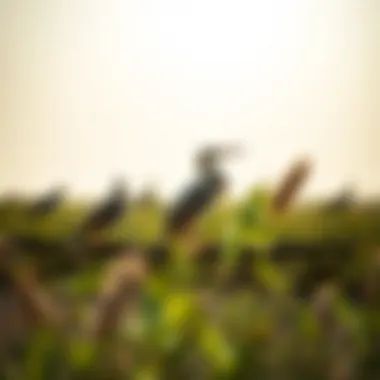

The sanctuary also shines brightly in its commitment to education and awareness. As a living classroom, it offers a variety of programs aimed at different age groups and interests. These initiatives serve to educate visitors about the importance of biodiversity and conservation in a fun yet substantive manner.
- Guided Tours: Knowledgeable guides lead most of the tours, providing in-depth information about the flora and fauna inhabiting the area. These tours often include fascinating anecdotes and facts that ignite curiosity among participants.
- Workshops and Events: The sanctuary regularly hosts workshops that cover various environmental topics. Whether it’s learning about migratory bird patterns or understanding the intricacies of sustaining wetland ecosystems, there’s always something happening that can pique interest.
- Family Programs: Aimed at engaging younger audiences, programs designed for families often involve hands-on activities like bird watching and nature trails. These experiences not only educate but also foster a love for the environment among kids and adults alike.
"Visiting Ras Al Khor is not merely an outing; it's an opportunity to reconnect with nature and appreciate the delicate balance that sustains it."
In summary, the visitor experience at Ras Al Khor Sanctuary is a multifaceted journey. With its accessibility and robust educational offerings, it stands out as a premier destination for anyone looking to explore Dubai's natural beauty while gaining a better understanding of ecological stewardship.
Future Prospects
The future prospects of Ras Al Khor Sanctuary are not merely about sustaining its current state, but rather about enhancing its role within Dubai's vibrant ecological framework. As the surrounding urban landscape continues to evolve, this sanctuary has the potential to become a central pillar in Dubai's commitment to environmental stewardship.
Understanding the prospects begins with recognizing the necessity for sustainable development goals. These goals serve as a compass guiding the intricate balance between human progress and ecological preservation. The sanctuary embodies a unique opportunity for stakeholders to endorse sustainable initiatives that align with environmental needs.
Sustainable Development Goals
At the heart of the sanctuary’s future lies the commitment to achieving sustainable development goals that prioritize environmentally friendly practices.
- Biodiversity Preservation: Protecting the habitats and species within the sanctuary is key. This can be achieved through stricter enforcement of environmental regulations, which will help bolster the wildlife population that calls Ras Al Khor home.
- Education and Awareness: Increasing community awareness about the importance of the sanctuary encourages local involvement. Educational initiatives can foster a sense of pride and responsibility, creating dedicated advocates for the sanctuary.
- Collaborative Efforts: Partnerships between the government, local communities, and businesses can yield innovative solutions for environmental challenges. Collaborative conservation programs not only enhance biodiversity but also strengthen community bonds.
Ras Al Khor is positioned to act as a model for other urban areas aiming for sustainable integration of nature within city plans. By focusing on these fundamental goals, the sanctuary can thrive, ensuring essential ecosystems are safeguarded for generations to come.
Potential for Eco-Tourism
Eco-tourism presents another promising avenue for Ras Al Khor's future, contributing to both economic growth and environmental conservation. This form of tourism emphasizes responsible travel, encouraging visitors to appreciate the natural world without causing harm. The potential here is staggering. Imagine a steady stream of tourists being educated about the diverse flora and fauna, while also significantly contributing to the maintenance of the sanctuary.
- Attracting Visitors: Unique experiences, like guided bird-watching tours or photography workshops, could draw in a range of tourists. Such activities not only engage visitors but also generate revenue that can be reinvested into conservation efforts.
- Local Business Growth: The rise in eco-tourism could galvanize local businesses. Hotels, restaurants, and tour operators might thrive as visitors seek to experience Dubai’s rich biodiversity. This potential encourages the community to engage in conservation efforts directly linked to their economic success.
- Cultural Significance: Eco-tourism can highlight the cultural and historical aspects of the area, offering a more enriching experience for visitors and increasing their appreciation for both nature and local culture.
Through strategic planning and development focused on eco-tourism, Ras Al Khor Sanctuary can solidify its status as not just a refuge for wildlife, but also as a keystone in the dialogue on sustainable urban living.
Ultimately, the future prospects of Ras Al Khor Sanctuary hinge on an integrated approach to sustainability, community involvement, and eco-tourism, ensuring that this natural gem continues to coexist harmoniously within the ever-expanding city of Dubai.
Important Note: Successful implementation of these initiatives requires a dedicated effort from everyone involved, from local citizens to international advocates for environmental conservation.
By nurturing these prospects, Ras Al Khor can transform itself into a bastion of ecological balance amidst the tides of urbanization.
Culmination
The concluding section of an article is crucial; it serves as the final signpost that guides the reader through the insights gathered during the exploration of Ras Al Khor Sanctuary. By wrapping up the discussion on this ecological marvel, we emphasize not just its intrinsic value, but also its role as a beacon for future conservation and development initiatives within Dubai.
Reiterating the Sanctuary’s Value
Ras Al Khor Sanctuary is more than just a collection of marshlands and wildlife; it represents a fine balance between urban growth and environmental preservation. The sanctuary plays a vital role in maintaining ecological diversity amidst intense urban expansion. The presence of numerous bird species, notably the vibrant flamingos that flock to the area, makes it a living testament to nature's resilience. Investors and real estate agents should recognize this sanctuary's significance when considering developments; it juxtaposes the fast-paced urban skyline with serene natural vistas. Investors often value properties that offer access to unique ecological landscapes, making the sanctuary not just a delight for nature enthusiasts but also a strategic asset for real estate ventures.
"Protecting natural habitats is essential for sustainable development and not just an environmental obligation."
Call for Continued Support
As we look to the future, the call for continuous support for Ras Al Khor Sanctuary must resonate with every stakeholder involved. Community engagement, government policies, and sustaining efforts at conservation should be our collective mission. Local stakeholders can play a pivotal role by participating in educational programs and initiatives aimed at preserving the sanctuary's biodiversity.
All hands must be on deck to address challenges, such as urban pressures and climate change. Investors and homebuyers alike have an opportunity here; supporting initiatives to protect and expand the sanctuary can not only preserve this natural jewel but also enhance property values and create a healthier urban setting.




